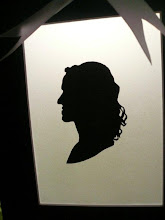


Inspired by
Ulla Milbrath's Reliquary Class I had a craft date with my friend John McRae and we set out to create our own personal reliquaries. But first of all, you may ask: "What exactly is a reliquary?" Well, according to Wikipedia : "A
reliquary (also referred to as a
shrine or by the French term
châsse) is a container for
relics. These may be the physical remains of
saints, such as bones, pieces of clothing, or some object associated with saints or other religious figures."
My reliquary is a resting place for a dead butterfly I found on my porch. I initially had placed him on a book shelf to keep him safe, but knew that I had to find a safer and permanent home for him soon. I lined his oval box with crushed velvet and embellished it with vintage gold cord and Dresden paper trim. I also included a poem by Philip Larkin, which reads:
"And the case of butterflies so rich it looks
As if all summer settled there and died"
I wrote this poem with my finest nib in my tiniest hand writing. I closed the box with a window made from mica and soldered the edges close. The size of the oval box is 3 and 3/4 inches by 2 and 3/4 inches.


























